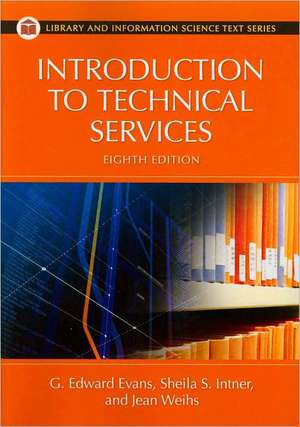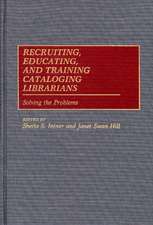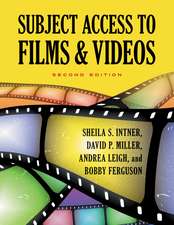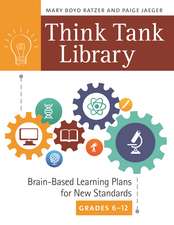Introduction to Technical Services: Library and Information Science Text Series
Autor G. Edward Evans, Sheila S. Intner, Jean Weihsen Limba Engleză Paperback – 8 noi 2010 – vârsta până la 17 ani
| Toate formatele și edițiile | Preț | Express |
|---|---|---|
| Paperback (1) | 398.74 lei 6-8 săpt. | |
| Bloomsbury Publishing – 8 noi 2010 | 398.74 lei 6-8 săpt. | |
| Hardback (1) | 402.10 lei 6-8 săpt. | |
| Bloomsbury Publishing – 10 noi 2010 | 402.10 lei 6-8 săpt. |
Din seria Library and Information Science Text Series
- 26%
 Preț: 346.94 lei
Preț: 346.94 lei - 17%
 Preț: 397.13 lei
Preț: 397.13 lei - 34%
 Preț: 368.61 lei
Preț: 368.61 lei - 26%
 Preț: 402.54 lei
Preț: 402.54 lei - 32%
 Preț: 355.47 lei
Preț: 355.47 lei - 18%
 Preț: 353.91 lei
Preț: 353.91 lei - 27%
 Preț: 345.08 lei
Preț: 345.08 lei - 23%
 Preț: 338.93 lei
Preț: 338.93 lei - 11%
 Preț: 352.01 lei
Preț: 352.01 lei - 26%
 Preț: 355.06 lei
Preț: 355.06 lei - 26%
 Preț: 356.01 lei
Preț: 356.01 lei - 18%
 Preț: 334.67 lei
Preț: 334.67 lei - 23%
 Preț: 338.52 lei
Preț: 338.52 lei - 26%
 Preț: 353.80 lei
Preț: 353.80 lei - 21%
 Preț: 413.93 lei
Preț: 413.93 lei - 17%
 Preț: 325.46 lei
Preț: 325.46 lei - 30%
 Preț: 262.32 lei
Preț: 262.32 lei - 17%
 Preț: 268.94 lei
Preț: 268.94 lei - 27%
 Preț: 384.89 lei
Preț: 384.89 lei - 13%
 Preț: 360.73 lei
Preț: 360.73 lei - 23%
 Preț: 395.77 lei
Preț: 395.77 lei - 23%
 Preț: 379.25 lei
Preț: 379.25 lei - 13%
 Preț: 362.63 lei
Preț: 362.63 lei - 13%
 Preț: 361.22 lei
Preț: 361.22 lei - 17%
 Preț: 308.11 lei
Preț: 308.11 lei - 23%
 Preț: 392.82 lei
Preț: 392.82 lei - 12%
 Preț: 363.38 lei
Preț: 363.38 lei - 22%
 Preț: 351.17 lei
Preț: 351.17 lei - 23%
 Preț: 344.93 lei
Preț: 344.93 lei - 18%
 Preț: 358.30 lei
Preț: 358.30 lei - 30%
 Preț: 263.78 lei
Preț: 263.78 lei - 12%
 Preț: 369.76 lei
Preț: 369.76 lei - 26%
 Preț: 358.85 lei
Preț: 358.85 lei - 26%
 Preț: 348.21 lei
Preț: 348.21 lei
Preț: 398.74 lei
Preț vechi: 512.47 lei
-22% Nou
Puncte Express: 598
Preț estimativ în valută:
76.31€ • 82.86$ • 64.10£
76.31€ • 82.86$ • 64.10£
Carte tipărită la comandă
Livrare economică 22 aprilie-06 mai
Preluare comenzi: 021 569.72.76
Specificații
ISBN-13: 9781591588887
ISBN-10: 159158888X
Pagini: 500
Dimensiuni: 178 x 254 x 36 mm
Greutate: 1.02 kg
Ediția:8Revizuită
Editura: Bloomsbury Publishing
Colecția Libraries Unlimited
Seria Library and Information Science Text Series
Locul publicării:New York, United States
ISBN-10: 159158888X
Pagini: 500
Dimensiuni: 178 x 254 x 36 mm
Greutate: 1.02 kg
Ediția:8Revizuită
Editura: Bloomsbury Publishing
Colecția Libraries Unlimited
Seria Library and Information Science Text Series
Locul publicării:New York, United States
Notă biografică
G. Edward Evans, a renowned Fulbright scholar, former university librarian, author and consultant, supervises the Harold S. Colton Memorial Library and Archives in Flagstaff, Arizona.Sheila S. Intner is professor emeritus, Simmons College's Graduate School of Library and Information Science at Mount Holyoke College, South Hadley, MA. Jean Weihs is a consultant, Technical Services Group, Toronto, Ontario.
Cuprins
ContentsPreface to the Eighth EditionPart I: General BackgroundChapter 1: INTRODUCTIONLibraries and Customer ServiceCustomer Service PhilosophyRole of Library ServicesWhat are Technical Services?Technical Services Background Knowledge Goals for Staff Summary Review QuestionsNotesSuggested ReadingChapter 2: TECHNICAL SERVICES ADMINISTRATIONTips for Effective Time ManagementTips for Meetings Tips for Team BuildingTips for Staff MotivationTips for CommunicationThe "More" Factor The Faster/Better/Cheaper FactorsRestructuring to Provide "Faster and Better"StandardsSummaryReview QuestionsNotesSuggested ReadingChapter 3: STAFFINGStaffing Categories Librarians Paraprofessional/Support Staff Other Full-Time StaffStaffing Process Recruitment Selecting the Pool InterviewingStaff Development, Training, and Retention Retention Training and DevelopmentPerformance AppraisalPart-Time Staff Students VolunteersSummaryReview QuestionsNotesSuggested ReadingChapter 4: TECHNICAL SERVICES ISSUETechnologyOutsourcing Cooperative/Consortial ActivitiesQuality AssuranceBudgetary IssuesSpaces for Technical Services Some Key Issues Planning IssuesSummaryReview QuestionsNotesSuggested Reading Part II: Acquisitions and SerialsChapter 5: ACQUISITIONS-OVERVIEWCollection Development and Acquisitions Types of Materials Acquired Print Materials Nonbook Materials Electronic ResourcesGeneral Procedures Request Processing Verifying Ordering Reporting Receiving Orders Acquisition Methods Serials ProcessingSummary Review QuestionsNotesSelected Web Sites and Discussion ListsSuggested ReadingChapter 6: DISTRIBUTORS AND VENDORSMaking the Selection-Factors to Consider What the Firm Stocks Vendor Technological Capability Speed of Delivery Financial Considerations Vendors' Services Customer Service Considerations Vendor Evaluation Retail Outlets Out-of-Print, Antiquarian, and Rare Book DealersSummary Review Questions NotesSelected Web SitesSuggested Reading Chapter 7: PRINT AND DIGITAL BOOKSWhat is Publishing? Types of Publishers Electronic Publishing E-Readers Technology and Information Producers Acquisitions and E-Resources The Google Books Library Project Summary Review QuestionsNotes Suggested ReadingChapter 8: E-RESOURCE ISSUESDifferences between E-Resource and Print Collection Building Ownership Issues Negotiating the License Group Decision Making Trials Purchase Price Staff and User Issues Technical Issues CancellationsAssessment of E-Resources Statistics Summary Review Questions Notes Suggested Reading Chapter 9: SERIALS-PRINT AND ELECTRONICWhat Is a Serial? Issues and Concerns Cost and Pricing Acquisition Processing Access Preservation Backfiles Changing Nature Assessment and Evaluation Summary Review Questions Notes Suggested Reading Chapter 10: GOVERNMENT INFORMATIONBackground E-Government Categories of Government Information U.S. Documents State and Local Governments Canadian Government Information Documents from Other Countries Access to Government Information Accessing U.S. Government Information Preservation of Government InformationFederal Depository Library Program Canadian Depository Programs Acquisition of Government Information Summary Review Questions Notes Suggested Reading Chapter 11: MEDIAMedia IssuesCurrent Media Formats Motion Pictures and Video Movie Ratings and Libraries Video and Copyright Other Image Formats Maps Audio Recordings Games Game Ratings Realia Microforms Preservation Microforms Film and Video Summary Review Questions Notes Suggested Reading Chapter 12: FISCAL MANAGEMENTProblems in Fiscal Management Library Fund Accounting Accounting Balance Sheet Accounts and Ledgers Journal Estimating Costs Allocation of Monies Encumbering VouchersOrder and Invoice Control Reconciliation of Accounts Audits Summary Review Questions Notes Suggested Reading Part III: Cataloging and ProcessingChapter 13: OVERVIEW AND DECISIONSThe Rationale for Good Cataloging Cataloging and Classification Processes Decisions Bibliographic Levels Subject Authorities Classification SystemsCatalog Displays A Word About the Figures and Examples Summary Review Questions Notes Suggested ReadingChapter 14: DESCRIPTION-IDENTIFYING MATERIALSAACR2: Past and Present Organization of AACR2-2005 Descriptive Structure and Data Sources ISBD Punctuation Creating the Description Area 1: Title and Statement of Responsibility Area 2: Edition Statement Area 3: Material Specific Details Area 4: Publication, Distribution, etc. Area 5: Physical Description Area 6: Series Area 7: Notes Area 8: Standard Numbers and Terms of Availability Rule Interpretations Summary Review QuestionsNotes Suggested Reading Chapter 15: ACCESS POINTS-RETRIEVING THE RECORDMain and Added Entries Selecting the Main EntrySelection Decision Tree Added Entries Name and Title Authorities Personal Names Corporate Bodies Geographic Names Uniform TitlesSummary Review QuestionsNotes Suggested Reading Chapter 16: SUBJECT ANALYSISDetermining Subject Matter Enumeration versus Faceting Subject Authorities: Subject Heading Vocabularies Principles of Subject CatalogingEvaluating Subject Catalogs Problems of the Subject CatalogSubject Authorities: Numbers for Classification Principles of ClassificationCall Numbers Evaluating Classifications Maintenance Issues Subject Analysis for Literary Works Why use Standard Systems? Summary Review Questions Notes Suggested Reading Chapter 17: SUBJECT AUTHORITIESLibrary of Congress Subject Headings The Publication Format of LCSH Entries Cross-References in LCSH Subdivisions in LCSH Other Subdivision Instructions LCSH's Canadian Complement Problems with LCSH LC's Children's and Young Adults' Cataloging ProgramSears List of Subject Headings The Publication Format of the Entries Advantages and Disadvantages of Using Sears Summary Review Questions Notes Suggested ReadingChapter 18: CLASSIFICATION SYSTEMSDewey Decimal Classification Format of DDC The Schedules A Closer Look at the Schedules A Closer Look at the Tables Library of Congress Classification Principles Underlying LCC Format of LCC Main Classes of LCC Subdivision in LCC Comparison of DDC and LCC National Library of Medicine Classification Background and Development Format of NLMC Main Classes and Subdivisions NLMC in Libraries"Copy" ClassificationSummary Review Questions Notes Suggested Reading Answers to the Classification Exercises Chapter 19: MARC FORMAT AND METADATAMachine-Readable CatalogingHistory and Background Elements of a MARC Record Fields Subfields IndicatorsContent Designation MARC Displays Bibliographic Networks and Shared Cataloging Metadata Dublin Core Metadata Encoding and Transmission Standard Metadata Object Description Schema Summary Review Questions Notes Suggested Reading Chapter 20: COPY CATALOGINGPolicy Issues 1. Acceptability of Sources 2. Record Fullness 3. Errors 4. Call Numbers 5. Tracings (Subject Headings and Added Entries/Access PointsOverview of the Operation Choosing the Source(s)SummaryReview Questions Note Suggested Reading Chapter 21: PROCESSING MATERIALSEvidence of Library Ownership Location Information Recording and Tracking Use Preservation and Security Summary Review QuestionsNotes Suggested Reading Chapter 22: LEADING THE CATALOG DEPARTMENTManagement Tasks Needed SkillsDepartment Policies and Procedures When Cataloging Standards Change Writing a Policy Manual Adopting the Policy Manual Current Issues Ten Hints for Leadership Patron Service First and Foremost Review QuestionsSuggested Reading Indexes Topical Index to the Text Index to Names Index to Figures Type of Media Access Points Description Classification
Recenzii
This substantial volume is the standard textbook for courses on technical services in library and information science (LIS) programs, and with good reason. It succeeds in doing what . . . an introductory textbook should do: balance high-level overviews of acquisitions and cataloging . . . with judiciously chosen details that are sufficient to elucidate the subject, but not so abundant as to completely overwhelm the inexperienced student. . . . Learners, at various stages of knowledge, will find Evans, Intner, and Weihs to be adept, trustworthy guides to the past, present, and probable future landscapes of technical services work.

















